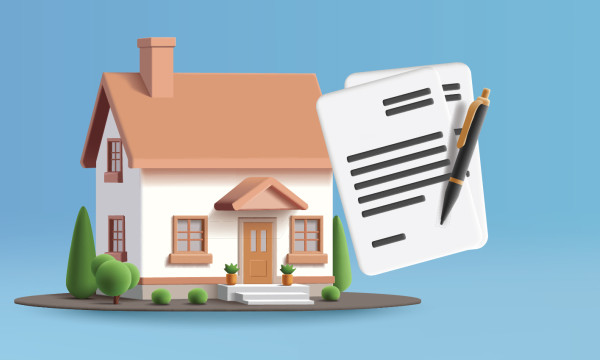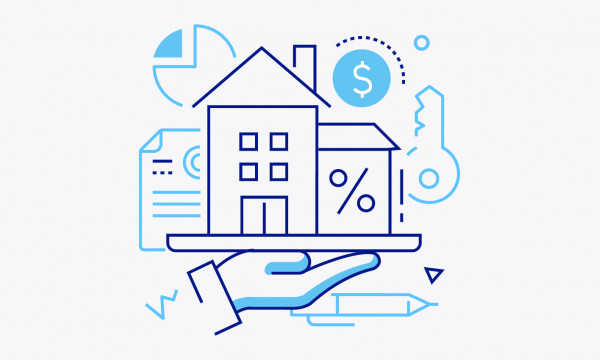What is an adjustable-rate mortgage?

If you’re on the hunt for a new home, you’re likely learning there are numerous options when it comes to funding your home purchase. When you’re reviewing mortgage products, you can often choose from two main mortgage options, depending on your financial situation.
A fixed-rate mortgage is a product where the rates don’t fluctuate. The principal and interest portion of your monthly mortgage payment would remain the same for the duration of the loan. With an adjustable-rate mortgage (ARM), your interest rate will update periodically, changing your monthly payment.
Since fixed-rate mortgages are fairly clear-cut, let’s explore ARMs in detail, so you can make an informed decision on whether an ARM is right for you when you’re ready to buy your next home.
How does an ARM work?
An ARM has four important components to consider:
- Initial interest rate period. At UBT, we’re offering a 7/6 mo. ARM, so we’ll use that as an example. Your initial interest rate period for this ARM product is fixed for seven years. Your rate will stay the same — and typically lower than that of a fixed-rate mortgage — for the first seven years of the loan, then will adjust twice a year after that.
- Adjustable interest rate calculations. Two different items will determine your new interest rate: index and margin. The 6 in a 7/6 mo. ARM means that your interest rate will adjust with the changing market every six months, after your initial interest period. To help you understand how index and margin affect your monthly payment, check out their bullet points:
- Index. For UBT to determine your new interest rate, we will review the 30-day average Secure Overnight Financing Rate (SOFR) — a benchmark federal interest rate for loans, based on transactions in the US Treasury — and use this figure as part of the base calculation for your new rate. This will determine your loan’s index.
- Margin. This is the adjustment amount added to the index when calculating your new rate. Each bank sets its own margin. When shopping for rates, in addition to checking the initial rate offered, you should ask about the amount of the margin offered for any ARM product you’re considering.
- Interest rate limits. Now that you’re aware of how interest rates are calculated when the initial interest rate period has ended, let’s look at the different limits that protect you by preventing the interest rate from infinitely adjusting.
- First interest rate adjustment limit. This is when your interest rate adjusts for the first time after the initial interest rate period. For UBT’s 7/6 mo. ARM product, this would be your 85th loan payment. The index is calculated and combined with the margin to give you the current market rate. That rate is then compared to your initial interest rate. Every ARM product will have a limit on how far up or down your interest rate can be adjusted for this first payment after the initial interest rate period — no matter how much of a change there is to current market rates.
- Subsequent interest rate adjustments. After your first adjustment period, each time your rate adjusts afterward is called a subsequent interest rate adjustment. Again, UBT will calculate the index to add to the margin, and then compare that to your most recent adjusted interest rate. Each ARM product will have a limit to how much the rate can go either up or down during each of these adjustments.
- Cap. ARMS have an overall interest rate cap, based on the product selected. This cap is the absolute highest interest rate for the mortgage, no matter what the current rate environment dictates. Banks are allowed to set their own caps, and not all ARMs are created equal, so knowing the cap is very important as you review options.
- Floor. As rates plummet, as they did during the pandemic, there is a minimum interest rate for an ARM product. Your rate cannot go lower than this predetermined floor. Just like cap, banks set their own floor too, so it’s important to compare products.
Frequency matters
As you review ARM products, make sure you know what the frequency of your interest rate adjustments is after the initial interest rate period. For UBT’s products, our 7/6 mo. ARM has a six-month frequency. So after the initial interest rate period, your rate will adjust twice a year.
Each bank will have its own way of setting up the frequency of its ARM interest rate adjustments. Some banks will adjust the interest rate monthly, quarterly, semi-annually (like UBT’s), yearly, or every few years. Knowing the frequency of the interest rate adjustments is vital to getting the right product for you and your finances.
When is an ARM a good idea?
Everyone’s financial situation is different, as we all know. An ARM can be a great product for the following situations:
- You’re buying a short-term home. If you’re buying a starter home or know you’ll be relocating within a few years, an ARM is a great product. You’ll likely pay less interest than you would on a fixed-rate mortgage during your initial interest rate period, and paying less interest is always a good thing.
- Your income will increase substantially in the future. If you’re just starting out in your career and it’s a field where you know you’ll be making much more money per month by the end of your initial interest rate period, an ARM might be the right choice for you.
- You plan to pay it off before the initial interest rate period. If you know you can get the mortgage paid off before the end of the initial interest rate period, an ARM is a great choice! You’ll likely pay less interest while you chip away at the balance.
We’ve got another great blog about ARM loans and when they’re good — and not so good — so you can further analyze whether an ARM is right for your situation.
What’s the risk?
With great reward (or rate reward, in this case) comes some risk. If the interest rate environment trends upward, so will your payment. Thankfully, with an interest rate cap, you’ll always know the maximum interest rate possible on your loan — you’ll just want to make sure you know what that cap is. However, if your payment rises and your income hasn’t gone up significantly from the beginning of the loan, that could put you in a financial crunch.
There’s also the possibility that rates could go down by the time your initial interest rate period is over, and your payment could decrease. Talk to your UBT mortgage loan officer about what all those payments might look like in either case.
If you have any questions about ARMs or fixed-rate mortgages, feel free to reach out to a member of our mortgage team, or check out our other ARM blog to get even more information.
Loan products subject to credit approval.
Learning Center articles, guides, blogs, podcasts, and videos are for informational purposes only and are not an advertisement for a product or service. The accuracy and completeness is not guaranteed and does not constitute legal or tax advice. Please consult with your own tax, legal, and financial advisors.






